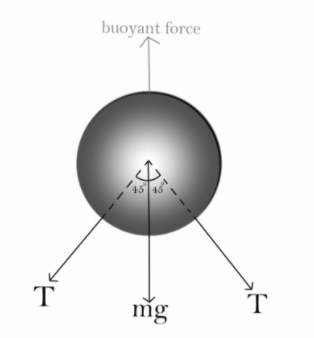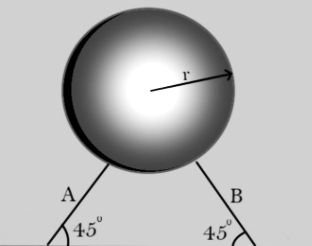Answer
440.1k+ views
Hint: The hollow sphere will experience a buoyant force acting upward due to the liquid. The gravitational force and tension of the wire pulls the sphere downwards.
Step by step solution:
First we'll make a free body diagram of the sphere for better understanding.

On balancing the forces, we get
Buoyant force$ = mg + T\sin 45 + T\sin 45$
$V\rho g = mg + 2T\sin 45$
$\dfrac{4}{3}\pi {r^3} \times \rho \times g = mg + \sqrt 2 T$
$\dfrac{4}{3}\pi {\left ( \sqrt[3]{\dfrac{3}{40\pi}} \right )^3} \times 1000 \times 10 = (50)(10) + \sqrt 2 T$
$T = 250\sqrt 2 N$
Hence option c is correct
The sin component of the tension of both wires cancels each other.
Additional information:
- Buoyant force is an upward force exerted by any fluid that opposes the weight of partially or fully immersed fluid. As we go deeper and deeper in a fluid column, the pressure increases. Thus the pressure at the bottom of a column of fluid is greater than the top of the column. The pressure difference results in net upward force on any object which is partially or fully immersed in a fluid.
- If the density of the object is greater than the density of liquid in which it is immersed then the object will sink. If the density of object and fluid are equal then the object will remain suspended in fluid. On the other hand if the density of the object is less than that of fluid, then the object will float.
Note: Please remember that the buoyant force exerted by liquid depends on the density of the liquid itself and not on the density of fluid.
Step by step solution:
First we'll make a free body diagram of the sphere for better understanding.

On balancing the forces, we get
Buoyant force$ = mg + T\sin 45 + T\sin 45$
$V\rho g = mg + 2T\sin 45$
$\dfrac{4}{3}\pi {r^3} \times \rho \times g = mg + \sqrt 2 T$
$\dfrac{4}{3}\pi {\left ( \sqrt[3]{\dfrac{3}{40\pi}} \right )^3} \times 1000 \times 10 = (50)(10) + \sqrt 2 T$
$T = 250\sqrt 2 N$
Hence option c is correct
The sin component of the tension of both wires cancels each other.
Additional information:
- Buoyant force is an upward force exerted by any fluid that opposes the weight of partially or fully immersed fluid. As we go deeper and deeper in a fluid column, the pressure increases. Thus the pressure at the bottom of a column of fluid is greater than the top of the column. The pressure difference results in net upward force on any object which is partially or fully immersed in a fluid.
- If the density of the object is greater than the density of liquid in which it is immersed then the object will sink. If the density of object and fluid are equal then the object will remain suspended in fluid. On the other hand if the density of the object is less than that of fluid, then the object will float.
Note: Please remember that the buoyant force exerted by liquid depends on the density of the liquid itself and not on the density of fluid.
Recently Updated Pages
Mark and label the given geoinformation on the outline class 11 social science CBSE

When people say No pun intended what does that mea class 8 english CBSE

Name the states which share their boundary with Indias class 9 social science CBSE

Give an account of the Northern Plains of India class 9 social science CBSE

Change the following sentences into negative and interrogative class 10 english CBSE

Advantages and disadvantages of science

Trending doubts
Difference between Prokaryotic cell and Eukaryotic class 11 biology CBSE

Which are the Top 10 Largest Countries of the World?

Fill the blanks with the suitable prepositions 1 The class 9 english CBSE

Differentiate between homogeneous and heterogeneous class 12 chemistry CBSE

Difference Between Plant Cell and Animal Cell

10 examples of evaporation in daily life with explanations

Give 10 examples for herbs , shrubs , climbers , creepers

Write a letter to the principal requesting him to grant class 10 english CBSE

How do you graph the function fx 4x class 9 maths CBSE




